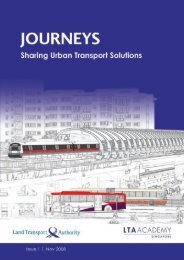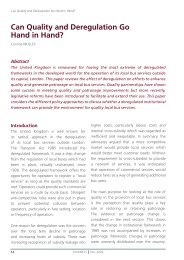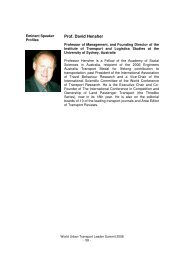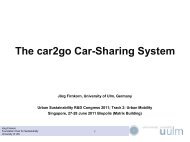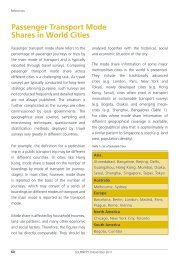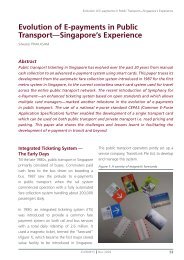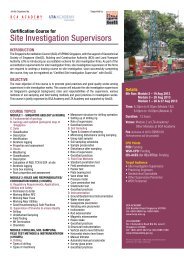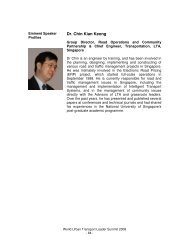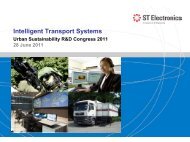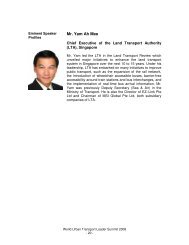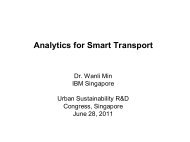Full Version - Issue 7 | November 2011 - LTA Academy
Full Version - Issue 7 | November 2011 - LTA Academy
Full Version - Issue 7 | November 2011 - LTA Academy
Create successful ePaper yourself
Turn your PDF publications into a flip-book with our unique Google optimized e-Paper software.
Table 2: Key Measures Adopted in the Smarter Travel Sutton Project<br />
Initiative Key Achievements<br />
Workplace travel planning – support and<br />
advice offered to larger employers to assist<br />
them in the development and implementation<br />
of their own travel plan<br />
School travel planning – each school<br />
was offered support and advice in the<br />
development and implementation of their<br />
own travel plan<br />
Personalised travel planning – every<br />
household was offered tailored travel<br />
information and incentives to use appropriate<br />
sustainable modes. Residents were also<br />
targeted through doctor referrals<br />
Car clubs – on-street vehicles that can be<br />
booked in advance and rented out by the<br />
hour by car club members<br />
Promotion of cycling – provision of cycle<br />
training, additional on-street cycle parking<br />
spaces, themed events<br />
Marketing, awareness and promotions –<br />
major festivals, events and roadshows, direct<br />
marketing campaigns, incentives and rewards<br />
The case study of Sutton offers some<br />
interesting and useful lessons in behaviour<br />
change that should be considered in the future<br />
application of TMM. Although the project has<br />
achieved measureable success, the adoption of<br />
some behavioural change theories could have<br />
increased the level of effectiveness of the overall<br />
approach taken. The Diffusion of Innovation<br />
Transport Mobility Management: Small Changes - Big Impacts<br />
• All major employers engaged; 16,000<br />
employees covered<br />
• Average 2% reduction in car use for work<br />
trips<br />
• First London Borough with 100% school<br />
travel plan coverage<br />
• Average 5% point reduction in car use<br />
for trips to school (some schools achieved<br />
reductions as high as 17%)<br />
• 52% of the participants who participated<br />
in the doctor referral scheme reported<br />
reducing their car use<br />
• 300 car club members and 16 vehicles in<br />
the scheme<br />
• Average utilisation equates to six hours per<br />
day per car<br />
• 50% increase in the number of recorded<br />
cycle trips compared to stable levels across<br />
other outer London Boroughs<br />
• Increase in awareness of available<br />
alternative travel modes<br />
• Contribution to mode shift results, e.g.,<br />
13% growth in the number of bus<br />
passengers in the borough compared to a<br />
9% increase in an adjoining borough<br />
model explains how a new technology or<br />
idea becomes adopted by a population.<br />
Those people who are first to adopt the new<br />
technology or idea are described as Innovators,<br />
followed by Early Adopters, Early Majority, Late<br />
Majority and Laggards. They can be arranged<br />
linearly on a bell curve as shown in Figure 2.<br />
JOURNEYS | <strong>November</strong> <strong>2011</strong><br />
23



